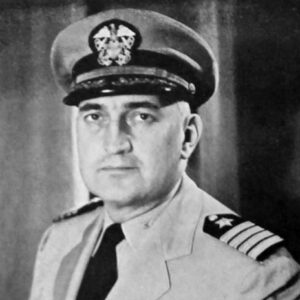calsfoundation@cals.org
Edward Baxter Billingsley (1910–1997)
Rear Admiral Edward Baxter Billingsley was a decorated naval officer and veteran of World War II who went on to a second career as a professional historian and expert in the history of the U.S. Navy’s role in South American affairs.
Edward Baxter Billingsley was born on June 18, 1910, in Melbourne (Izard County). He was the younger of the two children of Edmund Billingsley and Hattie Baxter Billingsley and a great-grandson of former Arkansas governor Elisha Baxter. His father spent most of his life as a merchant in Melbourne, though he maintained a store in Batesville (Independence County) for a time as well. Edward Billingsley was educated in the schools of both towns, graduating from Melbourne High School in 1926. After two years of study at the University of Arkansas (UA) in Fayetteville (Washington County), Billingsley was admitted to the U.S. Naval Academy at Annapolis, Maryland, in July 1928.
Graduating from the academy in 1932 and receiving his ensign’s commission, Billingsley served aboard the USS Nevada before reporting to China, where he saw duty aboard two different gunboats and a patrol yacht. Following two years as assistant engineering officer aboard the cruiser USS Chicago, he was assigned to the U.S. Naval Training Station in Norfolk, Virginia. While there, Billingsley married Californian Patricia Malloy on December 28, 1939. The couple remained married until his death but had no children.
In 1941, Billingsley received an assignment to be engineering officer on the destroyer USS Emmons, a new ship commissioned at Boston just two days before the Japanese attack on Pearl Harbor. As executive officer of the Emmons, he played a role in the invasion of North Africa in the fall of 1942. On July 4, 1943, after patrolling the Arctic and the North Sea, newly promoted Commander Billingsley assumed full command of the Emmons, which was soon after ordered to escort the battleship USS Iowa as it carried President Franklin D. Roosevelt across the Atlantic for the historic Tehran Conference.
The early part of 1944 found Billingsley and the Emmons on a U-boat-hunting mission before being summoned to England to prepare for the invasion of occupied France. Taking part in the landing at Normandy, the Emmons was said to have fired the first shots at the German defenses on Omaha Beach. On June 25, 1944, nineteen days after D-Day, Billingsley took part in the bombardment of Cherbourg, and two months later he and the Emmons participated in the invasion of southern France. The former earned Billingsley the Silver Star from the Secretary of the Navy, and for the latter he was awarded the Bronze Star. He was among the Americans who later received the Croix de Guerre with Silver Star from the French government for his role in the nation’s liberation from the Germans.
In the fall of 1944, Billingsley was given command of the destroyer USS John A. Bole, still under construction at Staten Island. Commissioned in March 1945, the Bole arrived at Okinawa in early summer and served on picket duty until the surrender of Japan. Billingsley and the Bole were present at Inchon, Korea, when U.S. forces came ashore six days after the official Japanese surrender. He personally oversaw the surrender of some 60,000 Japanese troops on the Korean island of Quelpart (now Jeju) and directed the disarmament and destruction of Japanese naval forces there.
Leaving his command of the Bole a year after the end of war, Billingsley earned a master’s degree in the navy’s new Personnel Administration and Training program at Northwestern University. Following two years with the Bureau of Naval Personnel, he returned to the seas as executive officer of the USS Columbus, flagship of the commander in chief of the Eastern Atlantic Mediterranean fleet. On New Year’s Day in 1951, Billingsley was promoted to the rank of captain and soon after came aboard the USS Macon as chief of staff and operations officer for Rear Admiral W. S. “Deak” Parsons. Through the 1950s, Billingsley served more than two years as base operations officer at Pearl Harbor, just over a year in command of the USS Montrose in the western Pacific, and as commanding officer of the naval station at Subic Bay, Philippines. He served the final two and a half years of his career as commanding officer of the U.S. Naval Reserve Training Center in Indianapolis, Indiana, retiring at the rank of rear admiral on November 1, 1959.
Following retirement from the navy, Billingsley studied at the Goethe Institute in West Germany before returning to the United States to pursue graduate studies at the University of North Carolina. Earning a PhD in Latin American history in 1965, he taught for two years in North Carolina before joining the faculty of the University of South Florida in 1967. That same year, the University of North Carolina Press published his revised dissertation as In Defense of Neutral Rights: The United States Navy and the Wars of Independence in Chile and Peru. After he retired from the University of South Florida in 1977, Billingsley began work on a history of the first ship he commanded, the USS Emmons. It was published privately in 1989 as The Emmons Saga and distributed to members of the USS Emmons Association. Admiral Billingsley remained in Tampa during retirement and died there on September 3, 1997. In October 1998, his cremated remains were buried at sea in the Atlantic Ocean, followed by a twenty-one-gun salute from the USS John Hancock.
For additional information:
“Captain Edward Baxter Billingsley.” Ramblin Rose (Publication of the USS Montrose Association), Issue 19 (Summer 1999).
Edward Baxter Billingsley Papers, 1942–1984. Manuscript Collection No. 782. Special Collections. East Carolina University, Greenville, North Carolina.
Karr, Shannon. A History of Izard County Arkansas. Little Rock: Democrat Printing and Lithographing Co., 1947.
Brooks Blevins
Missouri State University
 Education, Higher
Education, Higher Military
Military World War II through the Faubus Era, 1941 through 1967
World War II through the Faubus Era, 1941 through 1967 Edward B. Billingsley
Edward B. Billingsley 




When I, a freshly baked German PhD, was appointed Assistant Professor in the History Dept. at the University of South Florida in 1968, I became a colleague of Baxter Billingsley´s. He and his wife Patricia became very good friends of my wife’s and mine. Baxter was truly beloved by his students, then a not very docile crowd. These were the 1960s, and Baxter used to follow department meetings with amused patience. Incidentally, and surely to Baxter´s credit, Field Marshal Gerd v. Rundstedt, then in charge when the Emmons fired the first shots, was a relative of mine: his grandmother was my great-grandmother. What a fine, fine gentleman Baxter was, and how very kind and supportive to this young German, in other American quarters then still known as “the Nazi.” I am deeply impressed that Baxter received such a splendid biographical sketch. Oh, how he loved his Arkansas!